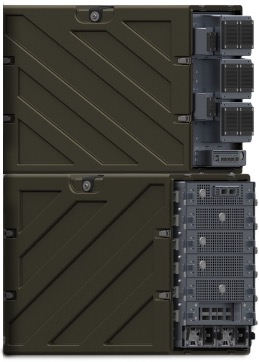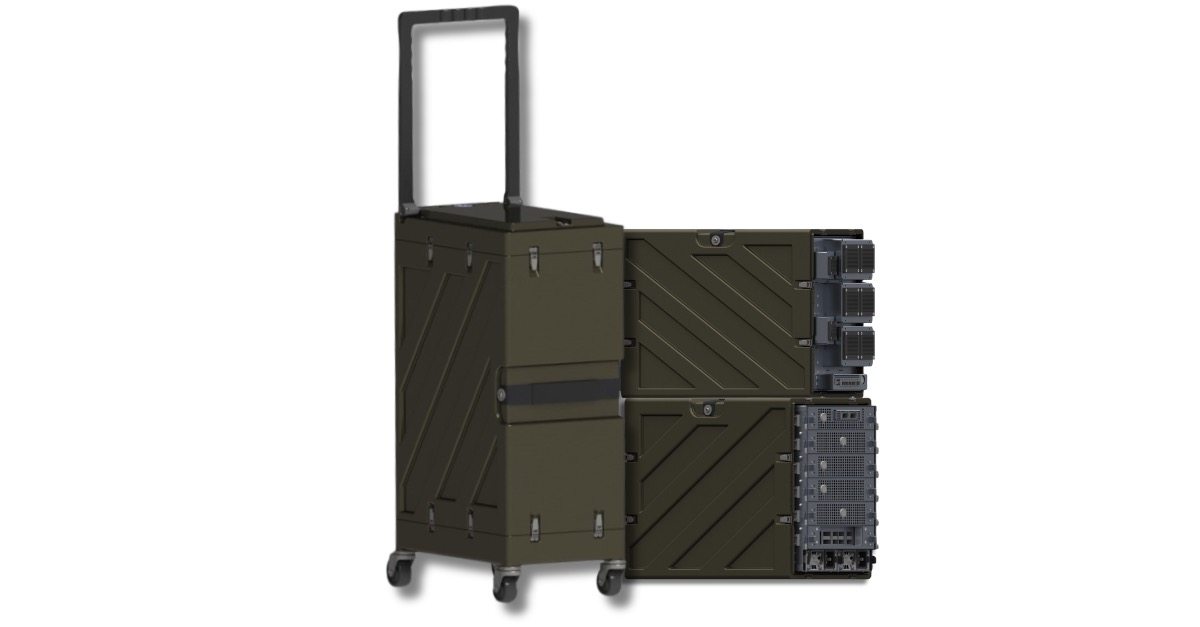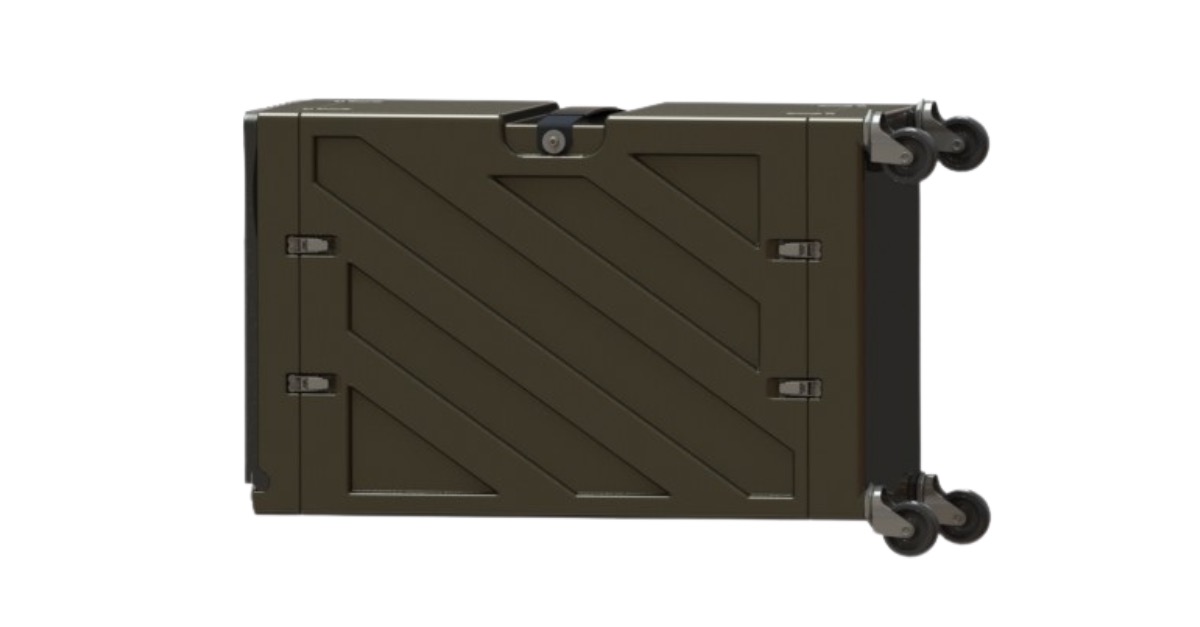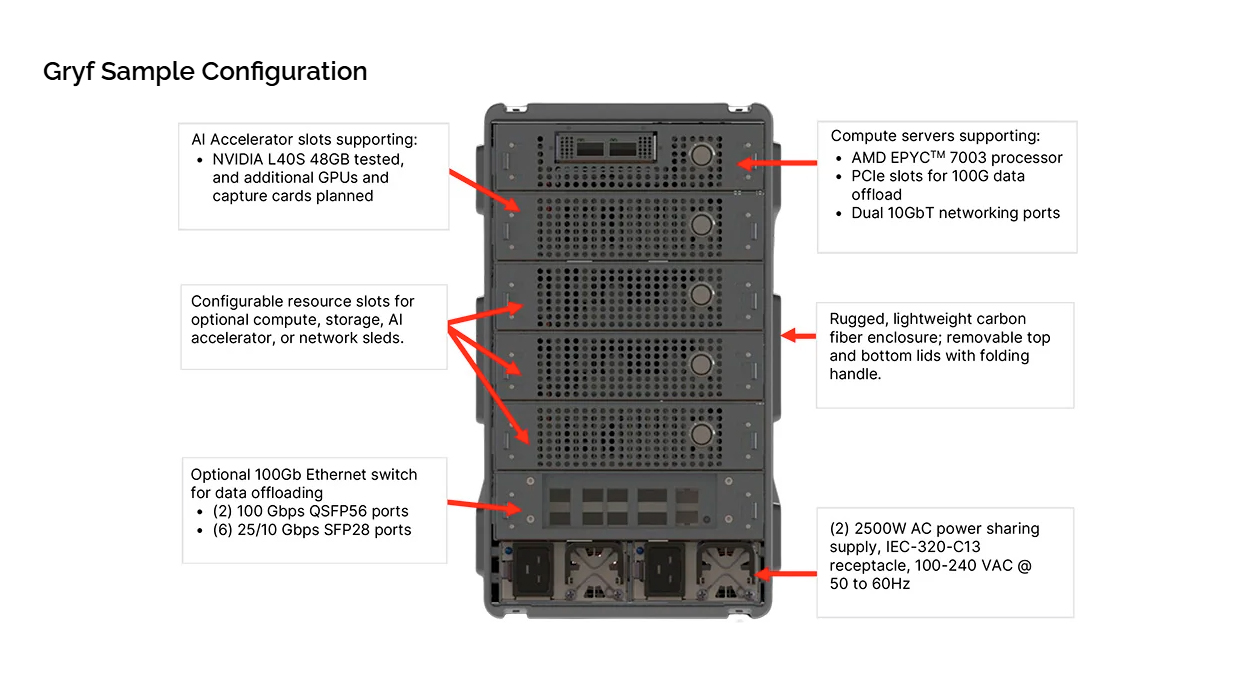Portable AI supercomputer comes as a carry-on suitcase with wheels — four GPUs, 246TB of storage, and a 2,500W integrated power supply
All passengers, please ensure your carry-on baggage has enough storage for your anticipated data needs

GigaIO and SourceCode have teamed up to bring the world an ultraportable but still supercomputer-class device for AI needs. The Gryf weighs 55 pounds or less and is packed into a TSA-friendly carry-on suitcase.
Despite the small form factor, Gryf can accommodate data collection and processing on a scale that would otherwise require sending the data offsite. This revolutionary development for use cases requires quick processing and analysis turnaround.
Gryf is a suitcase-sized supercomputer that supports disaggregating and reaggregating its GPUs. The user can customize the computer's hardware configuration in the field on the fly. You can create the optimal hardware configuration for one assigned workload and then change it for the next.
Each Gryf contains multiple slots populated with compute, storage, accelerator, and network sleds tailored to the workload. The suitcase-sized supercomputer has six sled slots to insert and remove modules from as needed.
For AI or ML workloads, for example, you might plug in two compute sleds, an accelerator sled, two storage sleds, and a network sled. Are you moving on to a storage project? Change the configuration to incorporate one compute sled and five storage sleds instead.
The specifications and capabilities for each type of sled and the Gryf platform itself are as follows:
| CPU | (1) AMD EPYC 7003 series, 7313, 16 cores/32 threads, 155W, 3Ghz base/3.7Ghz turbo |
| System Memory | (4) 64 GB DDR4 DIMMs (256 GB total), 3,200Mhz max |
| OS Storage | (1) 512GB NVMe-M.2 SSD |
| OS Support | Linux Rocky 8/9 or Ubuntu 20/24 |
| Networking | (2) QSFP56/QSFP28/QSFP+ 100GbE, copper/optical |
| BMC / IPMI | Via platform RJ45 |
| Accelerator Slot | Single/Double-wide PCIe-FHFL form factor, up to 350W |
| Accelerator | (1) Nvidia L40S-48GB (other options to be qualified) |
| Storage | (8) 30TB NVMe-E1.L SSD (246TB total) |
| Ports | (2) QSFP56-100GbE, copper/optical |
| Row 1 - Cell 0 | (6) SFP28-25GbE, copper/optical |
| Sled Slots | (6) for Compute Sled, Accelerator Sled, Storage Sled, Network Sled in any location |
| AI Memory Fabric | Internal: PCIe 256Gb/s board-to-board |
| Row 2 - Cell 0 | Expansion: (8) FabreX Mini-SAS-HD-32G 32Gb/s (256Gb/s total) for Gryf daisy-chaining or data offload at home base |
| Management Network | (5) RJ45-10GbE/1GbE for FabreX Fabric Manager and out-of-band (OOB) baseboard management controller (BMC) / IPMI |
| Software | GigaIO FabreX Fabric Manager Preloaded |
| Row 5 - Cell 0 | Linux & libraries: GPUDirect RDMA (GDR), Libfabric, and NVMe-oF |
| Power | Dual AC/DC 2,500W 1+1 power supplies |
| Row 7 - Cell 0 | IEC-320-C13 power inlet, 100-240 VAC @ 50 to 60Hz |
| Fans | (6) 60mm fans dynamically optimized for system workloads |
| Fan Filters | Removable 45 PPI filters |
| Dimensions | With wheels: 9.00″ x 14.00″ x 24.50″ (228.6mm x 355.6mm x 622.3mm) |
| Row 11 - Cell 0 | Without wheels: 9.00” x 14.00” x 22.00” (228.6mm x 355.6mm x 558.8mm) |
| Weight | Less than 55 lbs (24.95 kgs) max |
| Enclosure | Ruggedized carbon fiber, detachable top with folding handle, detachable bottom with wheels |
| Environment Operating temperature: | 10°C to 32°C (50°F to 90°F) |
| Serviceability | Field replaceable units (FRUs): sleds, power supplies, fan tray with fan filtration, case top and bottom covers |
| Compliance | FCC Class A, CE |







According to GigaIO and SourceCode, a single Gryf can be configured to process over a petabyte of information. Using GigaIO’s FabreX memory fabric, the Gryf can also be stacked with up to four other Gryfs for more demanding workloads.
Once back in the data center, the FabreX memory fabric allows Gryf to connect to the core computer, a GigaPod, for the more demanding processing and analysis tasks. Rather than waiting for days to transmit the data over internet connections, engineers collect and begin processing the data where it was gathered, then cart it off to the data center.
Get Tom's Hardware's best news and in-depth reviews, straight to your inbox.
Citing the needs of Department of Defense customers, GigaIO CEO Alan Benjamin pointed out the need to collect and process data where it happened in the field.
“This is true for our Department of Defense customers, who have emphasized the critical need for timely and actionable intelligence in the field. Gryf’s novel architecture, made possible by FabreX, our AI memory fabric, provides those customers the advanced compute, storage, and GPU capabilities they crave in today’s sensor-rich edge environments.”
The companies did not disclose pricing for the Gryf, but the mobile supercomputer is available for purchase now.

Jeff Butts has been covering tech news for more than a decade, and his IT experience predates the internet. Yes, he remembers when 9600 baud was “fast.” He especially enjoys covering DIY and Maker topics, along with anything on the bleeding edge of technology.
-
Ralston18 And when that portable suitcase wheels itself into the cockpit then that is when I will get off of the plane.Reply -
slightnitpick This modularity is quite neat. I believe the better word would be "minicomputer" though, instead of "supercomputer".Reply -
PEnns "..comes as a carry-on suitcase with wheels ...The Gryf weighs 55 pounds or less"Reply
I doubt the TSA and flight staff would consider this a carry-on!
And good luck lifting that heavy "carry-on" and storing it in the overhead compartments. And, finally, let's hope it doesn't fall on someone's head during the flight...;) -
Lewinator56 Reply
The TSA would demand it's taken apart, break it, smash the HDDs, then confiscate it because 'it might be export protected'.PEnns said:"..comes as a carry-on suitcase with wheels ...The Gryf weighs 55 pounds or less"
I doubt the TSA and flight staff would consider this a carry-on!
And good luck lifting that heavy "carry-on" and storing it in the overhead compartments. And, finally, let's hope it doesn't fall on someone's head during the flight...;)
Luckily, the civilised world doesn't have to deal with them.

